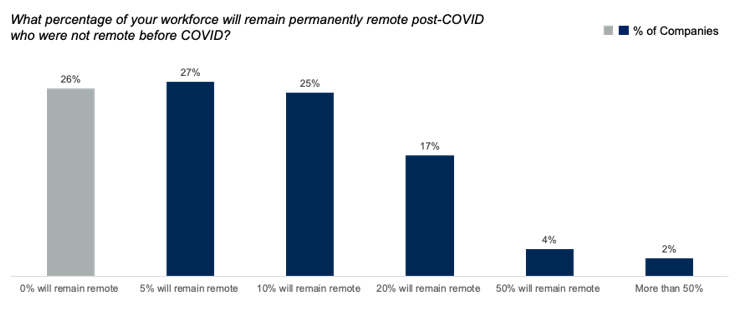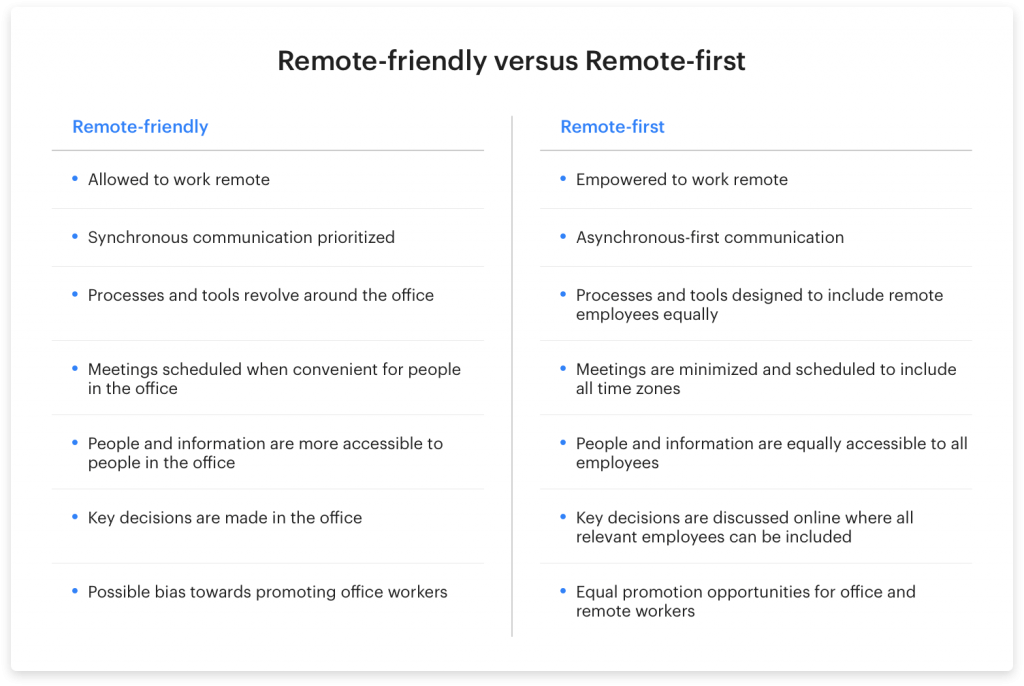
Gartner survey revealed that 74% CFOs intend to move at least 5% of the workforce to permanently remote positions post-COVID-19.

High-possibility your direct reports working remotely…
Then, are you a remote-first company OR a remote-friendly company? (Hint: you can’t interchange the terms)
This single element decides the company culture, hence affecting employee’s mental health & productivity.
Peoplebox bring you definitive guide covering exact definition, differences between the two. Later, sharing office requirements & advantages offered.
Scroll further!
Definition: Remote-first & remote-friendly
Remote-friendly company
If a company is remote-friendly, it allows employees to work remotely some of the time but most of the work is done in their physical office.
For instance, an employee may work from home for 1-2 days per week.
In remote-friendly companies, only certain people may allowed the privilege to work from home. However, the company culture is such that it is easier to work in the office.
Remote employees may feel invisible or ignored in such companies or may believe that they’re losing out on opportunities for career development.
In a remote-friendly company:
- Employees may choose to WFH for a few days in the week or month.
- Team members may be allowed to or may choose to work from home for extended periods.
- Remote workers can split their time between the many physical offices of the company.
- Employees are mostly free to choose their working hours, especially if the team consists of people living in different time zones.
Remote-friendly companies example: Amazon, Intercom, Microsoft, etc.

Remote-first company
In a remote-first company, work from home (or anywhere!) is the default way of working.
It isn’t viewed as a benefit for employees or included to make the company look progressive or radical.
The company may have been started with a non-centralized work setting in mind or it may have shifted to remote work after a crisis, such as the current COVID-19 pandemic, to reduce costs.
It is more likely the employees at a remote-first company don’t work in the same time zone because the company can source talent from literally anywhere in the world.
Not everybody is suited to work at remote-first companies. Employees require self-discipline, accountability, excellent communication skills, and flexibility to flourish in such settings.
When such companies hire people, they look for these qualities more than years of experience or technical skills.
Remote-first companies example: Zapier, Twitter, SkillShare, Slack, etc.
Remote-first vs. remote-friendly: How are they different?
You may say that the distinction between a remote-first vs. remote-friendly company is merely a technicality.
In practice, it makes a world of difference to employees.
Before we delve further into how these two types of companies are different, let us understand how the terms ‘distributed team’ and ‘remote team’ are also different.
Distributed teams
- Distributed teams are physically ALL distributed away from each other.
- Working from home or a co-working space where none of their team members work.
- Team members rarely see each other face-to-face and often work in different time zones and countries.
Remote teams
Team members are physically separated from each other, but not necessarily everyone in the company works from home or is situated on opposite ends of the world.
Team members working from home, but stay within a specified distance from a physical office where they meet with other employees frequently.
Thus, it stands to reason that remote-first companies have distributed teams, whereas remote-friendly companies have remote teams.
The important thing to remember is that no matter what the form, remote work can be challenging in addition to having its advantages.

There are a number of areas around which remote-first vs. remote-friendly companies differ:
1Attitude
As we’ve mentioned previously, a remote-friendly company considers wfh as a perk for selected employees.
A remote-first company structures itself around work from home–it’s built into its DNA. Often, the company is established with systems and processes geared around people distributed across the world.
2Communication
In a remote-friendly company, a majority of the decisions are taken after a face-to-face discussion. Everybody knows what has been discussed, so people are not rushing to document the communication or publish the decisions right away.
But the downside… there is no system to keep remote employees informed, so information often slips through the cracks. Thus, remote employees may lose the opportunity to contribute to discussions or have their say in an important decision.
In a remote-first company, remote tools for documentation and online communication are the norm. Nobody meets face-to-face, so systems are set up for the smooth flow of information and accessibility. Like, Various channels on Slack may be used to convey relevant information, such as company-wide communication, team communication, or project communication.
3Meetings
In remote-friendly companies, one on one meetings that take place in a physical office. Again the drawback… Remote team members may miss out on side conversations that take place between people sitting in the office.
People may be reluctant to include remote team members on ad hoc meetings or quick discussions because of the hassles of finding a meeting room or connecting promptly.
In a remote-first company, video calls are the go-to method of conducting meetings effectively.
The employee is as responsible as the company to ensure that these calls are as streamlined as possible — minimum distractions and background noise, stable Internet connection, effective tools, and proper equipment.
4Bonding
We all know… Office jokes and small talk are important components of team bonding, helping employees open up to each other in a way that cannot be replicated in group meetings.
In a remote-friendly company, remote team members (crucial chunk of members) miss out on the opportunity to build a rapport with their coworkers. This causes them to feel left out and disengaged.
In a remote-first company, everybody is a part of the distributed team so each person is on an equal footing.
Virtual water cooler conversations may happen over Slack channels, ensuring that everyone gets to chitchat and bond with each other.
ICEBREAKER QUESTIONS E-BOOK
Icebreaker questions you can ask in every meeting during the COVID-19 pandemic.
5Hiring
Remote-friendly companies may limit their hiring to people within a specific distance from their physical offices or may ask the potential hire to relocate.
Face-to-face time is still valued in such companies, so the candidate who is willing to move to the office location is often chosen even if other people have better skills.
A remote-first company, on the other hand, has access to a larger geographic area than the local market.
Such employers value talent and a good fit over location because there is no physical office.
Peoplebox super-charges your hiring & employees loyalty by turning happy employees into your brand ambassadors on Glassdoor in an organic way.Turn your happy employees into your brand ambassador
6Measuring productivity
In a remote-friendly company, an employee’s productivity may be measured by the number of office hours she has put in at work.
In a remote-first company, flexible working hours and productivity is measured on the basis of the results they show.

Benefits of a remote-first company
We’ll discuss the benefits of remote-first vs. remote-friendly companies to demonstrate how both approaches have certain advantages:
1Access to top talent
When you hire someone for a physical office, you try to ensure that the candidate lives within a reasonable distance of the office location and can easily commute to work every day.
A remote-first company does not suffer from these restraints. Talented people can be hired from anywhere in the world because the very nature of the company is distributed.
2Cost reduction
There are huge costs involved in maintaining one or more physical office locations — as several companies have realized during the current crisis.
A remote-first company structure can use the money saved to invest in improved tools and systems for its employees or to offer them some face-to-face time via team bonding events.
3Streamlined and effective work processes
In remote-first companies, employees are used to working with tools like Slack, Zoom, Microsoft Teams, and Google Docs so documenting all communications and updates becomes second nature.
In remote-friendly companies, people may not remember to document each and every change. This leads to miscommunication, disengagement, and a disruption of work processes.

4Increased employee productivity & loyalty
Several studies show that remote work helps employees become more productive because they can avoid the distractions that occur in physical offices.
This, in turn, causes an increase in employee retention. In the long run, it saves companies a ton of money and time.
5Reduced carbon footprint
When there’s no commute to and fro from office, employees are leaving a much-lowered carbon footprint.
Fewer vehicles on the road cause less pollution and less traffic, improving living conditions for everyone.
6Improved lifestyle
Finally, for people who are well-suited to the remote work lifestyle, a remote-first company offers the kind of flexibility a physical office cannot.
Employees can work around their family responsibilities and still produce effective results.
Benefits of a remote-friendly company
Even though it may seem tempting to run a remote-first company due to all the benefits, there are some factors that may convince you to retain a remote-friendly structure:
1More direct communication
Although it is possible to quickly and effectively communicate using online tools, there is no debate around the fact that face-to-face communication is the fastest way to get your message across.
It is also easier to build trust and rapport and strengthen working relationships when employees see each other every day at the office.
2More accountability
Again, although distributed team members report greater productivity and engagement when working remotely, it is still debatable whether there is enough accountability.
The sense of accountability one develops when working alongside one’s manager and coworkers cannot be matched with that of a distributed team member who works guided only by his self-discipline and intrinsic motivation.


OKR Software – Used by 500+ Companies
Transform your managers into leaders through personalized coaching, bite-size learnings and make it super easy for them to have meaningful 1:1s, check-ins, and align goals(OKRs).
OKR Software – Used by 500+ Companies
Transform your managers into leaders through personalized coaching, bite-size learnings and make it super easy for them to have meaningful 1:1s, check-ins, and align goals(OKRs).
3More in-office productivity
Distributed teams may claim to get more work done when they work at their own pace from their homes or co-working spaces, but they can potentially lose productivity if their digital tools fail.
For instance, if a technical failure takes out an employee’s Internet connectivity for hours, then she cannot get her work done for the day.
Were she in office, she could still get some other work done by brainstorming solutions with her coworkers or troubleshooting with the support team.
The team could still conduct meetings and make important decisions.
4Still avail the benefits of remote work
The biggest benefit of having a remote-friendly company is that you can still hire talented employees to work remotely and provide them the necessary infrastructure to be effective at work.
Of course, you’ll have to introduce a culture change in the office wherein remote employees feel they belong to the team and are not left out of meetings and discussions for the sake of saving time.
What do you need to be remote-first?
If you’re considering being remote-first, here are a few factors to keep in mind:
1Establish processes to support remote work
Without set processes, remote work can quickly unravel.
Establish processes and document changes, updates, and solutions to everything such as project management, one on one meetings, time tracking, and so on.
Be intentional about measuring output (results) rather than the input (hours worked).
Set measurable expectations and outline deliverables clearly.
2Define tools for communication and collaboration
Tools for communication and collaboration should be clearly defined to ensure that there are no knowledge gaps.
All conversations should be done on public channels instead of private chats to ensure that everyone has equal access to information.
Each employee should be logged in to the required systems for the smooth functioning of the remote-first company.
3Establish efficient systems for remote hiring and remote onboarding
Remote-first companies can extend their hiring net to people across the world, but they must keep legal rules and regulations of various countries in mind.
Onboarding and training are done fully remotely, so robust systems should be in place to make the new hire feel welcome and prepared for work.
4Build an intentional ‘remote by default’ culture
Employees at remote-first companies embrace remote work as a normal part of their day. That’s the major difference in a remote-first vs. remote-friendly scenario.
For instance, everyone joins in through video calls for meetings and there is no scope for side conversations that remote team members cannot hear.
When someone needs to present, it is done online instead of using a physical whiteboard–which forces remote team members to struggle to read through their screens.
Discussions are conducted on public channels so that everyone can contribute instead of using private chats.
Thus, a remote-first company depends on a culture of transparency, trust, and empowerment.

What do you need to be remote-friendly?
1Office space
A remote-friendly company is a hybrid company that allows and supports remote employees to some extent.
So, you’ll want to retain existing office properties that are currently vacant due to the pandemic because most of your employees will return.
2Safety and hygiene measures
Returning to work during a pandemic can be a nerve-wracking experience.
You’ll want to ensure that physical offices have been sanitized and measures have been put in to ensure the safety of workers in the office.
Social distancing norms should be maintained and enforced, which will necessitate a rejig of the existing floor plan.
3Remote work policy
A comprehensive remote work policy will help your remote team member work smoothly and avoid any disruptions.
Consider factors such as working hours, schedules, behavioral expectations, processes around communication and collaboration, and measures of productivity and success.
4Remote work equipment
You may consider offering a work from home set up (hardware + software) if you don’t want remote team members to use personal devices.
You’ll want to consider offering an allowance for high-speed internet and phone requirements.
It would also be good to designate a point of contact in the IT department who can support remote workers.
5Remote work security
An information security policy and a client confidentiality policy is required for remote team members.
You’ll need to determine which tools will be used to securely share sensitive documents with other team members.
You’ll also want to decide how to grant secure remote access to the company’s network.
So, are you remote-first or remote-friendly?
Now that you have clarity on remote-first vs. remote-friendly benefits and implications, you can determine which direction your company takes.
Think about your goals for the business and how comfortable you are distributing accountability among your team members.
If your priority is to build a good team while keeping costs low, a remote-first company may be best.
If you’re interested in building a team with excellent rapport while still availing some of the benefits of remote work, a remote-friendly company is better.










